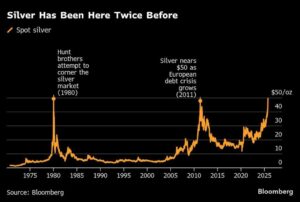The current silver price rally is back at center stage as prices touched $50( ₹4,162.50) per ounce, a level seen only twice since the 1970s. What gives some comfort is that this rally is not just about investment optimism; it’s powered by robust industrial demand, ongoing supply constraints, and wider use in global technology and green infrastructure. Understanding these shifts is vital for anyone assessing whether to invest or stay on the sidelines.
Gold and silver are both precious metals, but play distinct roles in the global financial system. Gold remains the reserve of choice for central banks, holding over 17% of official institutional reserves. This makes gold price movements more independent of basic supply-demand trends. In contrast, silver’s price is largely dictated by industrial demand and investor appetite; this results in volatility that is nearly double that of gold, with far more frequent and severe corrections. Silver requires significantly higher storage and safekeeping, considering the relative price differential. This discourages larger investments from central banks.
For the fifth year running, the silver market faces a notable supply deficit. In 2025, the shortfall is expected to be around 118–149 million ounces, largely due to industrial uptake and limited new mining projects.
Silver supply is especially sensitive because 75% of production comes from by-products of other metals like copper, zinc, and lead. This makes rapid supply increases challenging even when prices surge.
Silver has reached this $50/oz(₹4,162.50/oz) level twice before in 1980 and 2011. Each instance was followed by a steep correction (90% after 1980, and 72% following 2011). Peaks are usually marked by 10-year rallies with returns of 1000% or more.

Solar PV installations, particularly in China and the US, are breaking records and driving bulk silver demand. In 2025, installations are expected to consume more than 200 million ounces of silver. This segment is expected to keep rising despite efforts to make solar panels more efficient in silver usage per unit.
Silver investing can be somewhat of a rollercoaster, with steep price increases and abrupt declines that can leave even experienced investors gasping for air. These swings can feel unsettling in the moment, making you question your decisions or timing. Rather than letting short-term declines cause panic, successful investors step back and review the investment thesis, refine their strategies, and make thoughtful exit/entries. Staying steady through the turbulence requires both patience and perspective, and requires you to focus on making a calculated decision.
Given silver’s turbulent history, smart investing is paramount:
After silver’s strong rally, a price drop can feel a bit unsettling for any investor. But a dip like this often requires one to review the outlook and accordingly decide on the way forward. The long-term outlook for silver is positive due to its growing importance in clean energy, technology, and limited supply. However, we tend to underestimate the duration of corrective cycles. Hence, we recommend a phased or systematic investment in silver. Considering that silver is volatile, it’s a good idea to book some profits along the way to cushion any future bumps. What matters most is sticking to a disciplined plan to take advantage of volatile commodities.
 Talk to us
Talk to us
 Investor Grievance
Investor Grievance